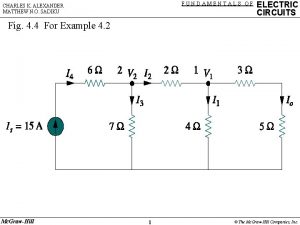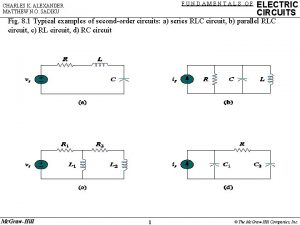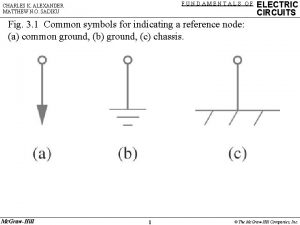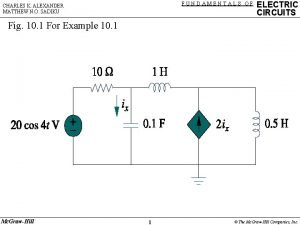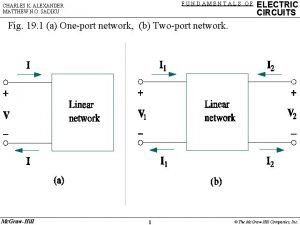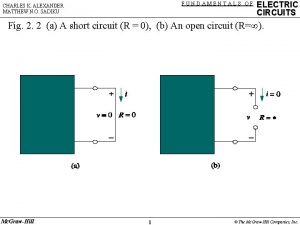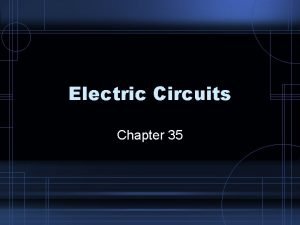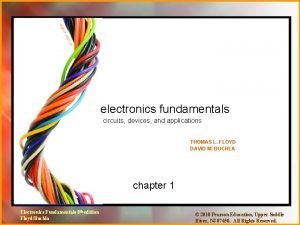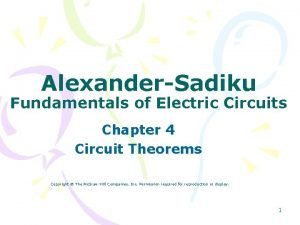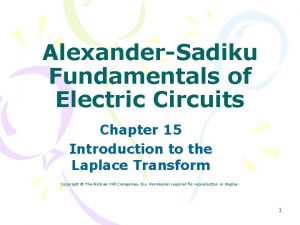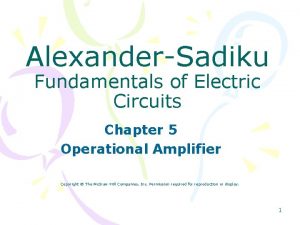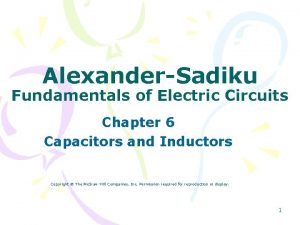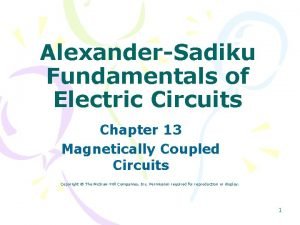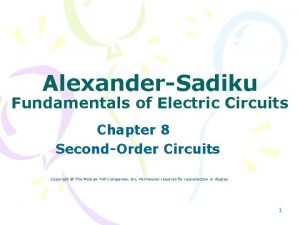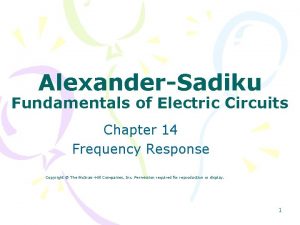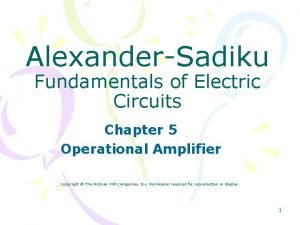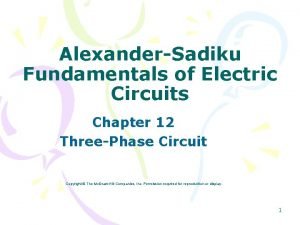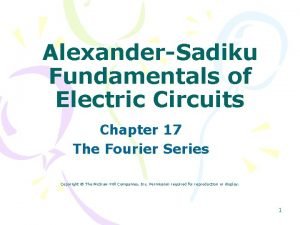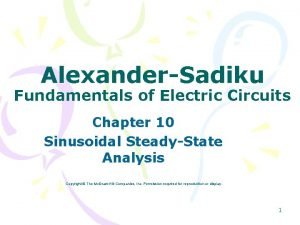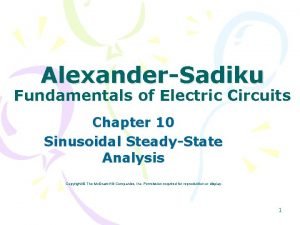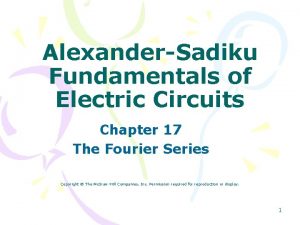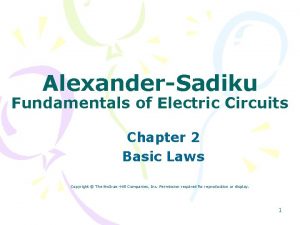AlexanderSadiku Fundamentals of Electric Circuits Chapter 4 Circuit





















- Slides: 21

Alexander-Sadiku Fundamentals of Electric Circuits Chapter 4 Circuit Theorems Copyright © The Mc. Graw-Hill Companies, Inc. Permission required for reproduction or display. 1

Circuit Theorems - Chapter 4 4. 1 4. 2 4. 3 4. 4 4. 5 4. 6 4. 7 Motivation Linearity Property Superposition Source Transformation Thevenin’s Theorem Norton’s Theorem Maximum Power Transfer 2

4. 1 Motivation (1) If you are given the following circuit, are there any other alternative(s) to determine the voltage across 2 W resistor? What are they? And how? Can you work it out by inspection? 3

4. 2 Linearity Property (1) It is the property of an element describing a linear relationship between cause and effect. A linear circuit is one whose output is linearly related (or directly proportional) to its input. Homogeneity (scaling) property v=i. R → kv=ki. R Additive property v 1 = i 1 R and v 2 = i 2 R → v = (i 1 + i 2) R = v 1 + v 2 4

4. 2 Linearity Property (2) Example 1 By assume Io = 1 A, use linearity to find the actual value of Io in the circuit shown below. *Refer to in-class illustration, text book, answer Io = 3 A 5

4. 3 Superposition Theorem (1) It states that the voltage across (or current through) an element in a linear circuit is the algebraic sum of the voltage across (or currents through) that element due to EACH independent source acting alone. The principle of superposition helps us to analyze a linear circuit with more than one independent source by calculating the contribution of each independent source separately. 6

4. 3 Superposition Theorem (2) We consider the effects of 8 A and 20 V one by one, then add the two effects together for final vo. 7

4. 3 Superposition Theorem (3) Steps to apply superposition principle 1. Turn off all independent sources except one source. Find the output (voltage or current) due to that active source using nodal or mesh analysis. 2. Repeat step 1 for each of the other independent sources. 3. Find the total contribution by adding algebraically all the contributions due to the independent sources. 8

4. 3 Superposition Theorem (4) Two things have to be keep in mind: 1. When we say turn off all other independent sources: Ø Independent voltage sources are replaced by 0 V (short circuit) and Ø Independent current sources are replaced by 0 A (open circuit). 2. Dependent sources are left intact because they are controlled by circuit variables. 9

4. 3 Superposition Theorem (5) Example 2 Use the superposition theorem to find v in the circuit shown below. 3 A is discarded by open-circuit 6 V is discarded by short-circuit *Refer to in-class illustration, text book, answer v = 10 V 10

4. 3 Superposition Theorem (6) Example 3 Use superposition to find vx in the circuit below. 2 A is discarded by open-circuit 20 10 V 10 V is discarded by open-circuit 20 v 1 + 4 (a) 0. 1 v 1 Dependant source keep unchanged v 2 2 A 4 0. 1 v 2 (b) *Refer to in-class illustration, text book, answer Vx = 12. 5 V 11

4. 4 Source Transformation (1) • An equivalent circuit is one whose v-i characteristics are identical with the original circuit. • It is the process of replacing a voltage source v. S in series with a resistor R by a current source i. S in parallel with a resistor R, or vice versa. 12

4. 4 Source Transformation (2) + + - - (a) Independent source transform (b) Dependent source transform • The arrow of the current source is directed toward the positive terminal of the voltage source. • The source transformation is not possible when R = 0 for voltage source and R = ∞ for current source. 13

4. 4 Source Transformation (3) Example 4 Find io in the circuit shown below using source transformation. *Refer to in-class illustration, textbook, answer io = 1. 78 A 14

4. 5 Thevenin’s Theorem (1) It states that a linear two-terminal circuit (Fig. a) can be replaced by an equivalent circuit (Fig. b) consisting of a voltage source VTH in series with a resistor RTH, where • VTH is the open-circuit voltage at the terminals. • RTH is the input or equivalent resistance at the terminals when the independent sources are turned off. 15

4. 5 Thevenin’s Theorem (2) Example 5 6 Using Thevenin’s theorem, find the equivalent circuit to the left of the terminals in the circuit shown below. Hence find i. 6 4 RTh (a) 6 2 A + VTh 4 (b) 16 *Refer to in-class illustration, textbook, answer VTH = 6 V, RTH = 3 W, i = 1. 5 A

4. 5 Thevenin’s Theorem (3) 5 Example 6 Find the Thevenin equivalent circuit of the circuit shown below to the left of the terminals. + 6 V 3 Ix a + VTh 4 i 2 i 1 1. 5 Ix i 2 i 1 o b (a) 0. 5 I 3 x 5 1. 5 Ix Ix i a + 1 V 4 (b) *Refer to in-class illustration, textbook, answer VTH = 5. 33 V, RTH = 3 W b 17

4. 6 Norton’s Theorem (1) It states that a linear two-terminal circuit can be replaced by an equivalent circuit of a current source IN in parallel with a resistor RN, Where • IN is the short circuit current through the terminals. • RN is the input or equivalent resistance at the terminals when the independent sources are turned off. Thevenin’s and Norton equivalent circuits are related by a source transformation. 18

4. 6 Norton’s Theorem (2) Example 7 Find the Norton equivalent circuit of the circuit shown below. 2 vx i + + vx 6 2 ix + vx 1 V + (a) 2 vx + 6 2 10 A + vx Isc (b) *Refer to in-class illustration, textbook, RN = 1 W, IN = 10 A. 19

4. 7 Maximum Power Transfer (1) If the entire circuit is replaced by its Thevenin equivalent except for the load, the power delivered to the load is: For maximum power dissipated in RL, Pmax, for a given RTH, and VTH, The power transfer profile with different RL 20

4. 7 Maximum Power Transfer (2) Example 8 Determine the value of RL that will draw the maximum power from the rest of the circuit shown below. Calculate the maximum power. + vx 4 v 0 + i 2 vx 4 Fig. a 2 1 1 + + 3 vx (a) 1 V + 9 V io + 3 vx + VTh => To determine RTH Fig. b => To determine VTH (b) *Refer to in-class illustration, textbook, RL = 4. 22 W, Pm = 2. 901 W 21
 Fundamentals of electric circuits chapter 4 solutions
Fundamentals of electric circuits chapter 4 solutions Fundamentals of electric circuits chapter 9 solutions
Fundamentals of electric circuits chapter 9 solutions Fundamentals of electric circuits chapter 7 solutions
Fundamentals of electric circuits chapter 7 solutions Charles k. alexander matthew n. o. sadiku
Charles k. alexander matthew n. o. sadiku Sadiku
Sadiku Sadiku
Sadiku Sadiku
Sadiku Electric circuits fundamentals floyd
Electric circuits fundamentals floyd Alexander
Alexander Alexander
Alexander Ise fundamentals of electric circuits
Ise fundamentals of electric circuits A suitable electric pump in an electric circuit is a
A suitable electric pump in an electric circuit is a Chapter 20 electric circuits
Chapter 20 electric circuits Conceptual physics chapter 35
Conceptual physics chapter 35 Chapter 20 electric circuits
Chapter 20 electric circuits Chapter 35 electric circuits answers
Chapter 35 electric circuits answers Ohm's law calculations worksheet
Ohm's law calculations worksheet Chapter 35 electric circuits
Chapter 35 electric circuits What is a parallel circuit in physics
What is a parallel circuit in physics Electronics fundamentals circuits devices and applications
Electronics fundamentals circuits devices and applications Chapter 21 electric charge and electric field
Chapter 21 electric charge and electric field Chapter 21 electric charge and electric field
Chapter 21 electric charge and electric field



